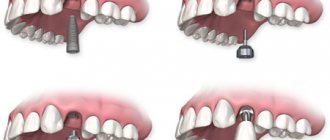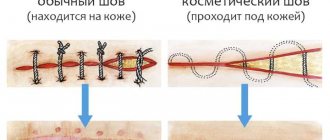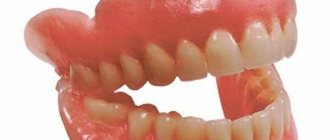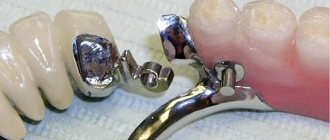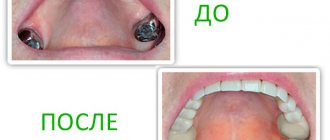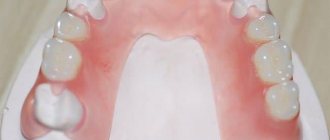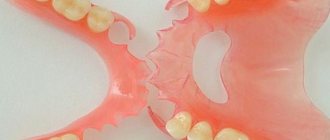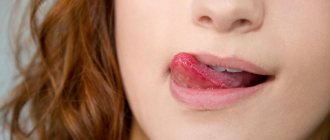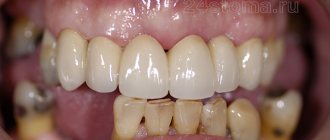A snow-white smile can be lost in youth, in maturity, and not only in old age. Sometimes a bridge is needed, and sometimes a denture is needed for the entire row. Suction cup dentures – modern technology, an effective method of solving the problem of missing teeth in the upper or lower jaw.
Elastic denture with suction cups
Myths about tooth loss
It has long been known that living a century is not a super task. This is probably approximately how long people should live. Myths, legends, and theological manuscripts contain information that life expectancy should be 600 years, 800, 1000. The reality is different. A record, but not uncommon, is 100-120 years. Most people live 60-80 years. Often the cause of death is illness, namely, diseases of the cardiovascular system - coronary disease, stroke. By the age of 35, most people are already missing at least one tooth. And if you don’t want to or can’t install a pin, you can use a prosthesis with suction cups in this case.
Absolutely all people in the modern world should live long and not get sick. Previously, life expectancy was affected by epidemics, constant internecine wars, and hard, exhausting work. There are fewer social problems in the 21st century, although they remain. There are economically developed regions on the planet and regions with weak economies. In countries with an unstable, deplorable economic situation, dental services can be expensive due to the fact that the materials and instruments used are modern. They are purchased at international market prices, but the domestic market makes their use unprofitable and unprofitable. Residents of such countries are less likely to go to the dentist. Often he uses removal instead of drilling or filling - a radical but inexpensive method. And yet, there are more and more opportunities for the further successful development of civilization. You can ask philosophical questions.
Is the loss of part of the dentition or the entire dentition a disease or not? Is it really possible to prevent them from falling out and still live a long life? So far, scientists do not have a definite answer, but research is already underway. The level of development of civilization, science, and technology makes it possible to conduct such research. Much attention is still paid to improving prosthetic methods. This is the only way to treat a problem whose occurrence cannot currently be avoided. Suction cup dentures are one such method.
It is believed that representatives of the fair half of humanity's teeth often fall out on their own. And representatives of the stronger half often damage them. Men love sports more, including those with a high risk of injury. In women, this is associated with reproductive function and pregnancy. This statement is only partially true. In fact, gender predisposition is a controversial issue, one of the myths, perhaps.
It has been proven that tooth loss:
- is a consequence of previous diseases;
- any disorders in the body;
- influence of circumstances;
- risks associated with professional activities.
If you do not install a prosthesis
Even when a complete set of teeth is missing, a person can live a normal life. The restrictions are minimal. You need to chop all the food carefully, use a knife - cut off a slice, not bite it off. For many centuries in a row, this condition of the oral cavity was considered the norm. Today it has been precisely established that complications may arise if a person has not purchased a prosthesis and does not use it. This can have a negative impact on your health, but only if certain factors are present. The onset of complications may be delayed in time.
There is a risk:
- deterioration of the condition of the jaw joint;
- development of gastrointestinal diseases.
Having lost one tooth or several, a person may sometimes not rush to the dentist. Should I worry? Is a prosthesis really necessary? Complications may arise. But they may not exist. It depends on your general health.
The motivation for treating the problem with prosthetics is:
- taking care of the beauty of the smile and face (the contour of the oval and facial expressions may change);
- aesthetic need (love of visiting restaurants, cafes can be the reason for using the method);
- love of comfort, desire to improve the level of quality of life (chewing food again, even if not all foods, is a pleasant feeling).
RESULTS
ROOM RESULTS Ñй денÑ. ROOM RESULTS, RESEARCH s RESULTS Ð½Ñ Ð²Ð°Ð ¶Ð½Ð¾ пÑи длиÑелÑном иÑполÑзовании аппаÑа SÑа. RESULTS s ¿»ÐµÐºÑÐ°Ñ Ñаз и навÑегда.
Dental health, beauty and functionality
Teeth begin to grow at around 3 years of age. They may be uneven and of irregular shape. At the age of about 7 years, the milk ones begin to fall out, and normal ones grow in their place. Their shape and row also sometimes do not correspond to beauty standards. Treatment in some cases, due to the individual characteristics of the human body, does not give the expected results. Only the so-called “Hollywood smile,” a traumatic and radical method, can change the situation.
At approximately 14 years of age, wisdom teeth begin to grow. They are sometimes called rudimentary formations and are recommended to be simply removed. They are difficult to form and grow incorrectly in many cases. And it’s easier to solve it at the first sign of a problem by removing it. There is little chance that wisdom teeth will grow in without complications.
The last pair of wisdom teeth, the so-called eights, grow in by the age of 25-30. From three years of age until this moment, the dentition is formed. Another 15-20 years will pass and teeth will begin to fall out due to the deterioration of the microflora of the oral mucosa, an imbalance of micro and macroelements, vitamins, a slowdown in the regeneration process in the body as a whole, changes in hormonal levels, the composition of saliva, and the balance of enzymes in it.
At some point, tooth extraction becomes a necessity, an inevitability. An inflammatory process may occur. Solid food, the chewing reflex, the habit of biting one way and not another, even if the dentist placed a bridge and crowns in a timely manner, injure the remaining natural teeth. They are loosening. Possible bacterial infection. Vision, hearing, and the condition of the nasopharynx may deteriorate against the background of such inflammation. I don't want to go to the doctor again. But it is undesirable to succumb to sentimentality and nostalgia. The procedure will provide relief, and full dentures with suction cups will help improve comfort later on. In this case, you will not have to sacrifice aesthetic needs or image.
Indications and contraindications
Direct indications for installing this method of prosthetics may include:
- fragmentary amputation of teeth;
- complete absence of the jaw row;
- the impossibility of using other methods of artificial restoration of lost organs.
A contraindication to their use is the presence of dental diagnoses in the oral cavity, regardless of the stage and nature of their course.
You still don’t know how to get used to a removable upper denture? Let's find out together.
Read here about alternatives to Butterfly dentures.
At this address https://www.vash-dentist.ru/protezirovanie/semnyie-p/pokryivnyie/zubnoy-novogo-pokoleniya-sendvich-podrobnoe-opisanie.html detailed information about the Sandwich removable denture.
Features of a prosthesis with suction cups
Dentures with suction cups
Dentures with suction cups are removable. Indication for use is complete or partial loss of teeth in the dentition. They are contraindicated if there is gum disease, as well as when there is an allergy to the materials from which they are made. Their effectiveness is based on the vacuum effect.
These prostheses:
- safe - do not rub, do not destroy microflora, blood circulation;
- they are easy to get used to;
- completely solve the problem of aesthetics, others will not be able to notice that this is a prosthesis;
- firmly fixed;
- they do not need to be changed for a long time - they last from 3 to 7 years;
- are inexpensive.
It is known that any product not only has its pros, but also its cons. This type of prosthesis is no exception. The disadvantages include:
- the need for daily maintenance of the structure;
- They will not fully replace the real ones in terms of feel and functionality.
It is believed that a permanent denture fixed with pins is a more reliable option. But this method has opponents. They decide to change their habits, chew, bite carefully, use cutlery more often to chop food, and purchase vacuum dentures. When installing permanent dentures, you still have to be careful. It may not be recommended for problems with the immune system, bone tissue, and more. At a certain age, they are too dangerous to place. And removable dentures with suction cups completely solve this problem. This method is absolutely non-traumatic.
There are two types of these prostheses:
- with the sky;
- without sky or telescopic.
In the first case, the upper part is securely fixed, but the lower jaw is a little more troublesome. There is a possibility that the prosthesis will interfere with the normal functioning of the salivary glands and dry mouth will appear. In the second case, we are talking about that very classic “Hollywood smile”. A removable denture consists of a metal base, acrylic and ceramics. It fits over the crown. Those are pre-sharpened.
They make dentures with suction cups from different materials. In particular:
- made of nylon;
- silicone;
- acrylic;
- polypropylene;
- polyurethane.
They choose the material taking into account their own preferences and doctor’s recommendations. In any case, a good choice will be made, because they look very aesthetically pleasing and help you lead a normal lifestyle, without any special restrictions. It's worth buying them. This will solve a lot of problems. For more reliable fixation, you can use special creams and gels that are sold in pharmacies. This will ensure the perfect effect. Reviews about these prostheses are positive.
Price
- Primary appointment (examination, consultation) with a dentist (special offer) 100001
For free
Promotion
- Prosthetics with partial removable lamellar dentures (up to 3 teeth) 153001
9 900 ₽
- Prosthetics with partial removable lamellar dentures 153002
29 000 ₽
- Manufacturing of removable prosthesis Quadrotti 153006
59 000 ₽
- Prosthetics with removable clasp dentures 153007
59 000 ₽
Removable dentures without a palate are compact orthopedic structures designed to restore the integrity of the upper row of teeth. Traditionally, the upper denture is equipped with a palatal plate for vacuum fixation to the hard palate. Adaptation to such products lasts up to 3 weeks. Some patients cannot get used to it and refuse prosthetics, which reduces their quality of life. A removable denture without a palate is much smaller. The patient gets used to it in 7-10 days.
Silicone vacuum dentures
The part that imitates the surface of the gums is made of silicone, and the teeth are made of plastic. Thanks to this material, it is possible to achieve an exact repetition of the individual relief of the oral cavity. They are fixed better and there is no discomfort during use. If irritation or pain occurs, then the prosthesis is not suitable. It takes very little time to get used to. They are designed for daily use. Such symptoms can be considered signs of incompatibility.
They are resistant to food containing pigments. Solid food cannot be chewed when using this type of denture. These are hypoallergenic dentures. The downside is the relatively high cost.
Is it possible to install a denture without a palate in the absence of teeth in the upper jaw?
Orthopedic devices without a plate are not installed in completely edentulous patients. It is necessary to have a jumper that will hold the device.
An alternative to removable prosthetics is implantation with the installation of a bridge. The most popular technology is All-on-4. The design is completely devoid of a bulky base. Attached to implants fixed in the bone. Implants transfer the load to the bone tissue, which slows down atrophic processes. Prostheses on implants function for 15 years. When using quality materials, the results last a lifetime.
Acrylic vacuum dentures
Acrylic plastic is the traditional material for their manufacture. This material allows you to create a less accurate imitation. But the aesthetic value is not lost. They look great. You have to look closely to notice the prosthesis. The right shade guarantees success.
The downside is that some people are allergic to this material. Her symptoms will not go away just by taking appropriate medications. It is necessary to exclude contact with the allergen. A silicone layer is used, which reduces the risk of allergies and improves the degree of fixation. The potential threat that exists due to the rather high density and hardness of the material is eliminated.
Nylon dentures
Nylon is a very soft, lightweight and durable material. The cost of nylon vacuum dentures is high precisely because of this. Their aesthetics make a positive impression, but silicone ones are a more accurate imitation. With nylon dentures, you should expect maximum comfort. With them, the person himself can briefly forget that he has a prosthesis. They are practically not felt when worn, but other varieties are still felt. Another plus is that the color can be repeated exactly. A nylon prosthesis for one tooth, even for the front one, is an excellent option, an alternative to more traumatic methods. One of the properties of this material is hygroscopicity. It absorbs moisture and due to this, the risk of microorganisms developing on the surface of the prosthesis is minimized.
Types and photos
They look very similar to natural teeth, the material is durable and easy to care for.
Acrylic products are made by injection molding.
They look very similar to natural teeth, the material is durable and easy to care for.
However, due to the ability to release toxic substances (in particular methyl ether), acrylic construction is contraindicated for allergy sufferers.
The main advantages of this type are: affordable price, aesthetics.
Disadvantages: porous structure, which provokes the formation of an unpleasant odor in the mouth due to food particles penetrating into the material; low resistance to mechanical stress.
Silicone products are a worthy alternative to acrylic prostheses, but unlike them they do not cause allergies. Such systems are suitable for partial or complete restoration of the dentition.
Their cost is almost the same, however, such designs have disadvantages. First of all, these are clasps, which provoke irritation and injury to the soft tissues of the oral cavity.
Other disadvantages include: porous structure, inability to be used on the lower jaw due to poor resistance to stress that occurs during chewing food.
Polyurethane products ideally combine decent performance characteristics, price and service life.
The material used is hypoallergenic, resistant to temperature changes and heavy loads. The design does not put pressure on the palate, and the taste buds also remain intact.
This promotes quick adaptation and comfortable wearing. The only significant disadvantage is the possibility of installing a polyurethane product only if you have your own teeth or implants.
Nylon dentures do not provoke allergies, are elastic, and skillfully imitate natural gums in color and appearance.
The advantages of the material are: no risk of injury to soft tissues, prevention of the accumulation of microorganisms due to hygroscopicity.
The downside of the nylon design is considered to be excessive flexibility, which is not able to evenly distribute the load during chewing movements. It is also worth noting that nylon requires special care, and if the prosthesis breaks, it is not possible to repair it.
Polypropylene products are flexible and do not cause an allergic reaction in the body. The main advantages are elasticity and special strength. To install the structures, no tooth preparation is required.
This is interesting: Restoring tooth crowns: is it possible to sharpen them without removing them, restoration and repair
There are no sharp or hard parts in it, which means the risk of injury is reduced to zero. Another pleasant addition to the characteristic is the affordable price, which is sometimes lower than acrylic products.
Suction cup prosthesis
Types of dentures with suction cups
There are several types of dentures in dentistry, but each case has its own advantages and disadvantages of use, which should be taken into account by all those who want to become the owner of a beautiful smile thanks to dentures. The choice of a particular option depends on the patient’s condition, his personal wishes and budget.
Full
There are 2 types of dentures with suction cups: partial and full. The greatest demand is for full products that are attached using a vacuum, fitting tightly to the palate and gum. More expensive models have minimal grip on the palate, but at the same time they are attached well and do not fall out during eating and talking.
Without sky
Dentures without a palate are called telescopic . Patients call this product a “butterfly” because of its appearance. The prosthesis is fixed to the teeth, which are previously covered with crowns. The base of the structure is made of durable metal, the function of the outer shell is performed by ceramics or acrylic.
A denture without a palate has several important characteristics:
- Patients have no gag reflex.
- Even distribution of load when chewing solid food.
- The period of operation of the structure is 9-12 years.
- During the use of the prosthesis, the soft tissues of the oral cavity are not injured.
- The broken part of the structure can be restored.
Among the disadvantages of dentures without a palate are the inflated price and the need to prepare supporting teeth.
Temporary structures
The main task of a temporary prosthesis is to prevent tooth displacement, which occurs in the absence of one or several units at once. This design is used in situations where it is reliably known that the treatment will be long-term.
While wearing a temporary structure, a person gets used to the presence of a foreign object in the mouth. For the manufacture of such structures, different types of plastic, as well as composite materials, are used.
Choosing the shade and color of the prosthesis is not difficult, but the desired fit of the structure to the gums cannot be achieved, since the material does not have sufficient plasticity. But for a temporary structure this drawback is not significant.
Types of materials
False jaws with suction cups can be made of different materials, which affects the final cost of the structure.
Most often, dental technicians make the base of the prosthesis from the following materials:
- Acrylic.
- Nylon.
- Polyurethane.
Each of these materials has its own advantages and disadvantages. The patient chooses the most suitable option together with his dentist, who gives professional recommendations. The individual characteristics of the jaw structure, medical indications and contraindications, the complexity of the specific situation, the patient’s wishes and the allocated budget are taken into account.
Acrylic systems
Suction dentures were initially made only from acrylic, which was invented in the last century. In their production, the injection molding technique is used. Acrylic bridges look very natural and completely follow the curves and shapes of the jaw. Acrylic structures are durable, easy to maintain and relatively inexpensive.
On the inside of the structure there is a special silicone insert. Its main function is to evenly distribute the chewing load on the left and right sides, which eliminates the development of atrophic or dystrophic processes.
In addition to its advantages, acrylic has its disadvantages that are worth paying attention to:
- The material is not flexible enough, so the edges of the prosthesis can injure the thin mucous membrane.
- When struck or dropped, acrylic easily breaks and crumbles.
- It is important to know that the material is slightly toxic. Methyl ether, which is contained in acrylic, is not dangerous to health in general, but often causes an allergic reaction. Allergy sufferers should immediately abandon this option.
- Acrylic dentures are hygroscopic (porous). Even with proper care, bacteria and pathogenic microorganisms accumulate in them. This causes bad breath and sometimes oral diseases.
- Acrylic is also prone to staining by foods or drinks. Over time, the removable structure loses its original appearance.
Nylon dentures
The use of nylon was the next step in prosthetics, making suction cup structures more advanced and comfortable. The material does not accumulate pathogenic microflora, is elastic, easy to use, and does not injure the oral mucosa.
Nylon dentures are difficult to distinguish from a real jaw. Nylon is characterized by a long service life, during which it does not stain or lose its appearance. An important advantage of the material is its hypoallergenicity and affordable price.
Disadvantages faced by patients:
- Nylon is difficult to care for. It can only be cleaned in a special solution. Do not use a toothbrush for cleaning; it can damage the denture.
- The material is flexible and durable, unlike acrylic. If it does break, repair is impossible. You will have to make new prints and pay for a new design.
Polyurethane structures
A special dental polyurethane plastic is called “dentalur”. It has many more advantages than disadvantages.
Polyurethane is flexible, elastic, it has good suction and holds firmly. The polymer is not prone to staining, can withstand significant loads and does not deteriorate when exposed to high temperatures. Polyurethane prostheses are non-toxic and do not cause allergies. Elastic plastic has a dense structure, which does not allow bacteria to accumulate.
Polyurethane is used both for the entire jaw and for its individual part (when only a few crowns need to be filled). Such dentures are miniature and do not cover the entire palate, which allows you to make maximum use of your taste buds and not feel discomfort.
Polypropylene - a classic material
Polypropylene is the classic option. The first removable vacuum dentures were made from it. And today it is used because the products have valuable characteristics. Prostheses are quickly manufactured. This material is lightweight and durable. It is characterized by transparency. During manufacturing, they do not try to replicate the color of the gums, since the natural color is not hidden. This makes the technology cheaper. At the same time, the prostheses remain invisible and are attractive from an aesthetic point of view. True, if a person is used to smiling often and the shape of the lips and jaw is such that a large area of the gums is visible, another option should be preferred. The individual characteristics of the human body and the characteristics of the situation play a decisive role in deciding which prostheses are best to choose.
Primary requirements
In order for the operation of the prosthesis to be comfortable and durable, a number of requirements are imposed on the design:
- absence of components that can provoke an allergic reaction;
- maximum correspondence of the outlines of the system to the natural relief of the jaw;
- maintaining the functionality of taste buds, which can be partially blocked by an incorrectly manufactured product;
- The model frame should not cause partial subsidence of the gum tissue with its weight. If this occurs, the device should be replaced immediately.
Design features of the Quadrotti removable denture and the material used for manufacturing.
This publication contains details about breakage and repair of removable dentures.
Here https://www.vash-dentist.ru/protezirovanie/semnyie-p/byugelnyie/atsetalovyiy-zubnoy-opisanie-plyusyi-i-minusyi-stoimost.html all about the technology for making acetal dentures.
Caring for removable vacuum dentures
The dentist will definitely tell you which care products are best to buy. There are rules that must be followed when using. In particular, it is advisable to remove and disinfect them after a meal. They should be brushed twice a day with a soft-bristled toothbrush. Before putting on the prosthesis, it is also necessary to disinfect the oral cavity. They are soaked overnight in a special solution.
To treat the oral cavity, you need some products, and to care for dentures, others. TM Corega is a well-known brand, popular, often recommended by specialists and consumers. The product range includes all the medications you need for self-care. With their help, you can fix the prosthesis, whiten it, and disinfect it. If they don't help solve the problem, perhaps your dentist can help solve it, it's time to make an appointment.
Manufacturing and installation
The technological process of installing dental structures on suction cups is divided into several mandatory procedures:
- The doctor's consultation .
The specialist reviews the clinical situation and prescribes diagnostic tests to identify possible contraindications. Together with the patient, the choice of material for the manufacture of the future product is made. If dental problems are identified that can be eliminated, the doctor provides appropriate treatment. - Making an impression. An accurate imprint is made using the classical method using special impression material. The copy will later serve as a template in the dental laboratory to create a permanent model.
- Model fitting . This manipulation is mandatory to eliminate defects that interfere with comfortable wearing. If any deficiencies are identified, the copy will be corrected.
- Control fitting session . The doctor evaluates the system for its ideal condition, advises the patient on the nuances of correct installation and removal of the product, and gives recommendations for care.
- Installation of the structure . This process is carried out by the patient at home. To make the attachment more durable, you can use special formulations in the form of a paste or gel, available in a wide range at pharmacies.
Suction cup denture for one tooth
It is possible to install a prosthesis on one tooth - this design is called a “butterfly”. The procedure is temporary, since the “butterfly” is not attached very securely.
How installation works on one tooth:
- the patient, together with the doctor, selects the material;
- an impression is taken (if the damaged tooth is still in place, an impression is made before it is removed);
- a removable denture for one tooth is made in the laboratory;
- The dentist tries it on and makes adjustments if necessary.
An important advantage of the butterfly is that it does not require preparation (grinding) of adjacent teeth. This makes the procedure less invasive, less painful and quicker.
A one-tooth bridge does not hold firmly, it can easily fall out, so it is better to avoid hard foods. It is worth using additional fixing agents. Twice a week it is removed overnight and placed in a disinfecting solution. The rest of the time you can leave it on before going to bed.


